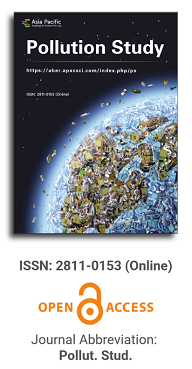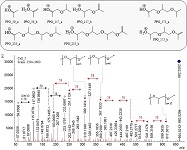
Asia Pacific Academy of Science Pte. Ltd. (APACSCI) specializes in international journal publishing. APACSCI adopts the open access publishing model and provides an important communication bridge for academic groups whose interest fields include engineering, technology, medicine, computer, mathematics, agriculture and forestry, and environment.

The (partial) replacement of synthetic polymers with bioplastics is due to increased production of conventional packaging plastics causing for severe environmental pollution with plastics waste. The bioplastics, however, represent complex mixtures of known and unknown (bio)polymers, fillers, plasticizers, stabilizers, flame retardant, pigments, antioxidants, hydrophobic polymers such as poly(lactic acid), polyethylene, polyesters, glycol, or poly(butylene succinate), and little is known of their chemical safety for both the environment and the human health. Polymerization reactions of bioplastics can produce no intentionally added chemicals to the bulk material, which could be toxic, as well. When polymers are used to food packing, then the latter chemicals could also migrate from the polymer to food. This fact compromises the safety for consumers, as well. The scarce data on chemical safety of bioplastics makes a gap in knowledge of their toxicity to humans and environment. Thus, development of exact analytical protocols for determining chemicals of bioplastics in environmental and food samples as well as packing polymers can only provide warrant for reliable conclusive evidence of their safety for both the human health and the environment. The task is compulsory according to legislation Directives valid to environmental protection, food control, and assessment of the risk to human health. The quantitative and structural determination of analytes is primary research task of analysis of polymers. The methods of mass spectrometry are fruitfully used for these purposes. Methodological development of exact analytical mass spectrometric tools for reliable structural analysis of bioplastics only guarantees their safety, efficacy, and quality to both humans and environment. This study, first, highlights innovative stochastic dynamics equations processing exactly mass spectrometric measurands and, thus, producing exact analyte quantification and 3D molecular and electronic structural analyses. There are determined synthetic polymers such as poly(ethylenglycol), poly(propylene glycol), and polyisoprene as well as biopolymers in bags for foodstuffs made from renewable cellulose and starch, and containing, in total within the 20,416–17,495 chemicals per sample of the composite biopolymers. Advantages of complementary employment in mass spectrometric methods and Fourier transform infrared spectroscopy is highlighted. The study utilizes ultra-high resolution electrospray ionization mass spectrometric and Fourier transform infrared spectroscopic data on biodegradable plastics bags for foodstuffs; high accuracy quantum chemical static methods, molecular dynamics; and chemometrics. There is achieved method performance |r| = 0.99981 determining poly(propylene glycol) in bag for foodstuff containing 20,416 species and using stochastic dynamics mass spectrometric formulas. The results highlight their great capability and applicability to the analytical science as well as relevance to both the fundamental research and to the industry.
Investigation into the passivating efficacy of various passivators on cadmium (Cd)-contaminated soil in Enshi
Vol 4, Issue 2, 2023
Download PDF
Abstract
To address the issue of cadmium (CD) contamination in the Enshi Mountain vegetable-growing soil, a pot experiment was conducted to assess the impact of various passivators (including biochar, hydroxyapatite, lime powder, fly ash, and a blend of organic passivators) on the passivation of Cd in the test soil, as well as on the yield, quality, and Cd content of Chinese cabbage. The findings revealed that while lime powder treatment hindered the growth of Chinese cabbage, all other treatments enhanced the fresh weight and height of the plants, with the fly ash treatment increasing the fresh weight of Chinese cabbage by 109.72%. Hydroxyapatite, lime powder, and the mixed passivator raised the soil pH by 25.18%, 36.61%, and 28.21% respectively. None of the treatments significantly affected the activities of soil urease, cellulase, and sugarcane enzyme, but biochar and mixed passivator treatments significantly boosted phosphatase activity by 52.85% and 69.82%, respectively, while lime powder treatment significantly suppressed it. All five passivator treatments decreased the Cd content in Chinese cabbage, with biochar, hydroxyapatite, lime powder, and mixed passivator treatments showing significant suppression, with lime powder being the most effective at reducing Cd by 73.80%. None of the treatments significantly impacted the quality of Chinese cabbage. Biochar and mixed passivator treatments lowered the total Cd content in the soil by 27.21% and 46.98% respectively, while lime powder and mixed passivator treatments reduced soil ion-exchangeable Cd by 67% and 47.35% respectively. The application of these five passivators was effective in reducing the Cd content in Chinese cabbage. Specifically, the mixed passivator treatment not only maintained the yield and quality of Chinese cabbage but also enhanced soil enzyme activity and decreased the proportion of total and effective Cd (ionic and water-soluble) in the soil.
Keywords
References
- Song W, Chen S, Liu J, et al. Variation of Cd concentration in various rice cultivars and derivation of cadmium toxicity thresholds for paddy soil by species sensitivity distribution. Journal of integrative agriculture. 2015; 14(9): 1845-1854.
- Tang S, Wan N, Zeng M, et al. Geochemical characteristics of selenium and cadmium in soil and crops in Enshi area. Geophysical and Geochemical Exploration. 2020; 44(3): 607-614.
- Singh A, Sharma RK, Agrawal M, et al. Health risk assessment of heavy metals via dietary intake of foodstuffs from the wastewater irrigated site of a dry tropical area of India. Food and chemical toxicology: an international journal published for the British Industrial Biological Research Association. 2010; 48(2).
- Xiao W, Ye X, Zhang Q, et al. Evaluation of cadmium transfer from soil to leafy vegetables: Influencing factors, transfer models, and indication of soil threshold contents. Ecotoxicology and environmental safety. 2018; 164: 355-362.
- Zhu B, Wang Y, Guo B, et al. Risk assessment of dietary exposure to cadmium in Nanjing citizens from 2013 to 2016. Practical Preventive Medicine. 2019; 26(9): 1027-1030.
- Ding S, Li Y, Liu B. Analysis of the current situation of nutrition, safety and quality testing of domestic fresh vegetables. Vegetables. 2014; (2): 29-32.
- Zhu F, Qiu Z, Jiao Z, et al. Development status and suggestions of Hubei alpine vegetable industry. China Vegetables. 2020; (3): 5-11.
- Zhou X, Zhang Y, Yin M. Study on the distribution characteristics and influencing factors of soil Cd in northern Enshi. Humic Acid. 2018; (2): 21-27.
- Tang S, Wan N, Zeng M, et al. Geochemical characteristics of selenium and cadmium in soil and crops in Enshi area. Geophysical and Geochemical Exploration. 2020; 44(3): 607-614.
- Miao X. Treatment and remediation of heavy metal pollution in soil. Resource Conservation and Environmental Protection. 2020; (11): 107-108.
- Cui J, Ma Y, Wang C, et al. Research progress of in situ passivation remediation technology for cadmium pollution in farmland soil. China Agricultural Science Bulletin. 2017; 33(30): 79-83.
- Diels L, Van D, Bastiaens L. New developments in treatment of heavy metal contaminated soils[J]. Reviews in environmental science & biotechnology. 2002; 1(1): 75-82.
- Wang X, Long T, Zhang J, et al. Passivation and remediation effect of soil passivators on Cd in phosphogypsum contaminated soil. Hubei Agricultural Science. 2020; 59(12): 68-71.
- Sun C, Li Y, Zhang Y, et al. Research progress of heavy metal passivators in farmland. Shandong Agricultural Science. 2016; 48(8): 147-153.
- Wang C, Ma Y, Yu Q, et al. Study on the effect of passivating agents on the speciation and stability of heavy metals in farmland soil. China Agricultural Science Bulletin. 2016; 32(1): 172-177.
- Zhou C, Zhang Z, Huang Z, et al. Research progress on passivation and remediation of heavy metals in acidic soil by different passivators. China Agricultural Science Bulletin. 2020; 36(33): 71-79.
- Du C, Mu L, Wang H, et al. Effects of different passivators and their combinations on the growth and absorption of Pb Cd as Zn in maize (Zea mays). Journal of Agricultural and Environmental Sciences. 2016; 35(8): 1515-1522.
- Li S. Soil Environmental Quality Agricultural Land Soil Pollution Risk Control Standard (Excerpt). Humic Acid. 2018; (4): 58-61.
- Xu Z, Yu G, Zhang X, et al. Soil enzyme activity and stoichiometry in forest ecosystems along the NorthSouth Transect in eastern China (NSTEC). Soil biology & biochemistry. 2017.
- Mayor ÁG, Goirán SB, Vallejo VR, et al. Variation in soil enzyme activity as a function of vegetation amount, type, and spatial structure in fire-prone Mediterranean shrublands. Science of The Total Environment. 2016; 573: 1209-1216. doi: 10.1016/j.scitotenv.2016.03.139
- Domínguez MT, Holthof E, Smith AR, et al. Contrasting response of summer soil respiration and enzyme activities to long-term warming and drought in a wet shrubland (NE Wales, UK). Applied Soil Ecology. 2017; 110: 151-155. doi: 10.1016/j.apsoil.2016.11.003
- Hu S. New insights into passivation remediation technology for heavy metal pollution in farmland soil. Science and Technology Innovation. 2018; (21): 161-162.
- Cao X, Wei X, Dai G, et al. Research progress of soil heavy metal complex pollution and its chemical passivation remediation technology. Chinese Journal of Environmental Engineering. 2011; 5(7): 1441-1453.
- Ashrafzadeh S, Leung DWM. Development of Cadmium-Safe Crop Cultivars: A Mini Review. Journal of Crop Improvement. 2016; 30(2): 107-117. doi: 10.1080/15427528.2015.1134743
- Zornoza R, Guerrero C, Mataix-Solera J, et al. Assessing air-drying and rewetting pre-treatment effect on some soil enzyme activities under Mediterranean conditions. Soil Biology and Biochemistry. 2006; 38(8): 2125-2134. doi: 10.1016/j.soilbio.2006.01.010
- Yang N, Liang Q, Gao Y, et al. Effects of heavy metal and phthalate compound pollution on soil enzyme activity. Jiangxi Agricultural Journal. 2019; 31(9): 116-120.
- Feng D, Wang J, Teng Y. Effects of copper, zinc and lead composite pollution on soil hydrolase activity. Journal of Agricultural Resources and Environment. 2015; 32(4): 411-417.
- Chen Z, Zhu H, Zhou Z, et al. Effects of modified montmorillonite to remediate cadmium pollution on enzyme activities in rice rhizosphere soil. Journal of Agricultural Resources and Environment. 2019; 36(4): 528-533.
- Du C, Duan Z, Zeng M, et al. Effects of different combinations of passivators on the absorption of Cd, As and Pb by maize (Zea mays) under field conditions. Journal of Ecological Environment. 2015; 24(10): 1731-1738.
- Wu L, Zeng D, Mo X, et al. Study on the stabilization effect of different passivators on heavy metal polluted soil. Environmental Science. 2015; 36(1): 309-313.
- Liang J. Evaluation and restoration technology of soil heavy metals Cu, Cd and F complex pollution [PhD thesis]. Hefei: Anhui Agricultural University; 2009.
- Li J. Study on the passivation of fly ash on lead and cadmium contaminated soil under different modification conditions [PhD thesis]. Yangling: Northwest A&F University; 2019.
- Li J, Chen S, Zhou Y, et al. Effects of different soil passivators on soil cadmium bioavailability. Anhui Agricultural Sciences. 2017; 45(36): 94-97.
- Hale B, Evans L, Lambert R. Effects of cement or lime on Cd, Co, Cu, Ni, Pb, Sb and Zn mobility in fieldcontaminated and aged soils. Journal of hazardous materials. 2012; 199(15): 119-127.
- Malandrino M, Abollino O, Buoso S, et al. Accumulation of heavy metals from contaminated soil to plants and evaluation of soil remediation by vermiculite. Chemosphere. 2011; 82(2).
- Cai D, Xiao W, Li G. Research progress of applying lime to improve acid soil. China Agricultural Science Bulletin. 2010; 26(9): 206-213.
- Fan C, Zhou X. A preliminary study on the improvement of acidified soil in Enshi Mountains. Hubei Agricultural Science. 2012; 51(4): 693-695.
- Dai Y, Lv J, Cao Y, et al. Effects of lime and organic matter on cadmium availability in cadmium-contaminated soils with different properties. Journal of Agricultural and Environmental Sciences. 2014; 33(3): 514-519.
- Ding J, Wen Y, Shu Q. Discussion on the transformation of cadmium and zinc in soil environment. Urban Environment and Urban Ecology. 2001; (2): 47-49.
- Chen S, Zhu Y, Ma Y. Effects of adding hydroxyapatite on soil lead adsorption and desorption characteristics. Environmental Chemistry. 2006; (4): 409-413.
- Guo J. Study on the effect and mechanism of fly ash passivation of soil heavy metals Cd and Pb [PhD thesis]. Linfen: Shanxi Normal University; 2016.
- Lin X, Jing Y, Gong Ch, et al. Research progress on adsorption of heavy metals by biochar. Environmental Pollution and Prevention. 2014; 36(5): 83-87
Supporting Agencies
Copyright (c) 2023 Jiajia Ming, Jiqian Xiang, Yu Kang, Lin Huang, Yongbo Chen, Yong Qu, Baishun Hu, Hongqing Yin
License URL: https://creativecommons.org/licenses/by/4.0

This site is licensed under a Creative Commons Attribution 4.0 International License (CC BY 4.0).
.jpg)
Beijing University of Technology, China



